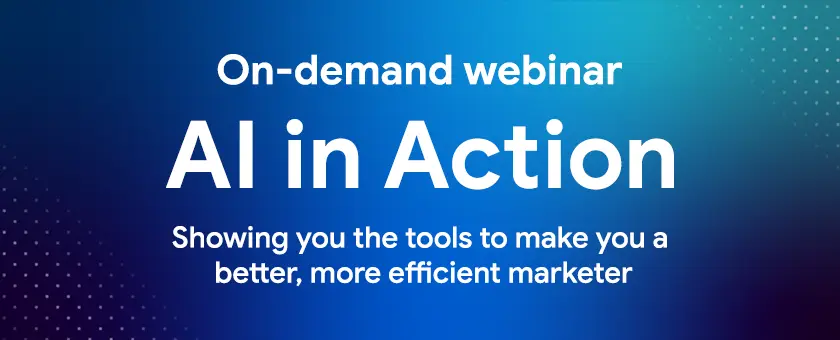Artificial Intelligence (AI) is one of those terms that’s often talked about, but not always understood.
The good news is that thanks to today’s automation platforms, marketers don’t require an in-depth knowledge of how artificial intelligence works, instead they can focus on the possibilities it presents.
The basics
At its most simple explanation, the term AI refers to software used by computers to help them mimic aspects of human intelligence. For example, a program that recommends your next book purchase, based on books you’ve previously bought.
This software uses sets of instructions – each set is known as an algorithm, which helps the computer navigate a series of decisions at lightning speed.

What it isn’t
AI has had a rough time in terms of image. For many people it conjures up images of robots going mad and taking over the world. This is pure science fiction. The reality is that AI can be pretty basic – a good example of an AI you use regularly without knowing is the spam filter in your email.
But AI, and the machines that use it, will only ever be able to operate within the scope of the task they’ve been trained in. To put it another way, a machine can’t decide it wants to learn a new skill and go off and teach itself.
So you can sleep easy tonight that your Alexa isn’t plotting to take over the world.
The benefits to marketers
Using AI means that marketers can scale the number of campaigns and journeys they create and deploy, but without making those decisions manually. AI takes care of defining which campaign to send to each customer next, based on the different scenarios it’s been trained to respond to.
AI models can quickly analyse customer behaviours and determine the next-best-action for them, optimising marketing automation.
And this is where ‘machine learning’ comes into play as AI can grow to become more accurate, the more data it has to learn from. In practical terms this is an impossible task to perform manually, so the implications for marketers are game changing.
Because the technology side has been taken care of, marketers can then concentrate on the thing that’s most important: communicating with customers and nurturing relationships.

A crystal ball
By analysing thousands of customer journeys, RedEye’s platform uses AI to accurately predict key moments in the customer lifecycle.
For instance, if you’re a marketer who has organised your data and already offering personalised communications, AI and automation takes things to another level in helping to understand individual customer behaviours and, crucially, predict how they will act in the future.
But this is more than just a crystal ball for marketers. This is about predicting behaviour and then taking specific actions to nudge or support them through the next step.
Identifying VIPs is a good example. Using a predictive model means you can see who your next VIP customers might be.
A predictive model, like the ones we use at RedEye, picks up attributes or similar behaviours of those who are now VIPs and uses that information to predict those among the rest of your customer base who are likely to become a VIP.
Using personalised communications you can segment and nurture these customers into becoming VIPs quicker and easier.

Using AI-Driven marketing automation to identify VIP customers and those likely to churn
Travis Perkins, a leading builders merchants, used AI and predictive analytics to increase its VIP customer segment by 65%. In this example, the VIP model searched for patterns of behaviour that reflected the behaviour of current VIPs.
This gave Travis Perkins the opportunity to use multi-channel communications to engage those customers, encouraging them to join this incredibly valuable customer segment.
Machine learning ensures these algorithms are constantly honed and tweaked to provide ever more accurate insight specifically in step with your brand.
For any brand, increasing VIPs means increased engagement and increased spend. The same was true for Travis Perkins, which saw an overall increase in its VIP segment to 5.3% of its customer base. Imagine the increase in spend that could be achieved for your brand.
Predictive analytics can be used at multiple points of the customer lifecycle. For instance, AI can also reduce the risk of customer churn – identifying patterns of behavior that are likely to lead to customers heading elsewhere.
These customers can then be automatically targeted with personalised promotions or incentives to restore loyalty.

AI: the only way is up
AI is set to play a larger role in marketing generally, with brands experimenting with everything from AI chatbots powered by natural language processing, running as part of their customer service response to spotting consumer trends.
Additionally, AI can be used to maintain quality of data in a CRM system, identifying customer records where errors or duplicates are likely to exist.
All this is good news. AI is nothing to be scared of, and marketers don’t need to retrain as data scientists. For marketers, AI is your new best friend, and predicting customer behaviours is much easier than you think.
What could AI do for your business?




